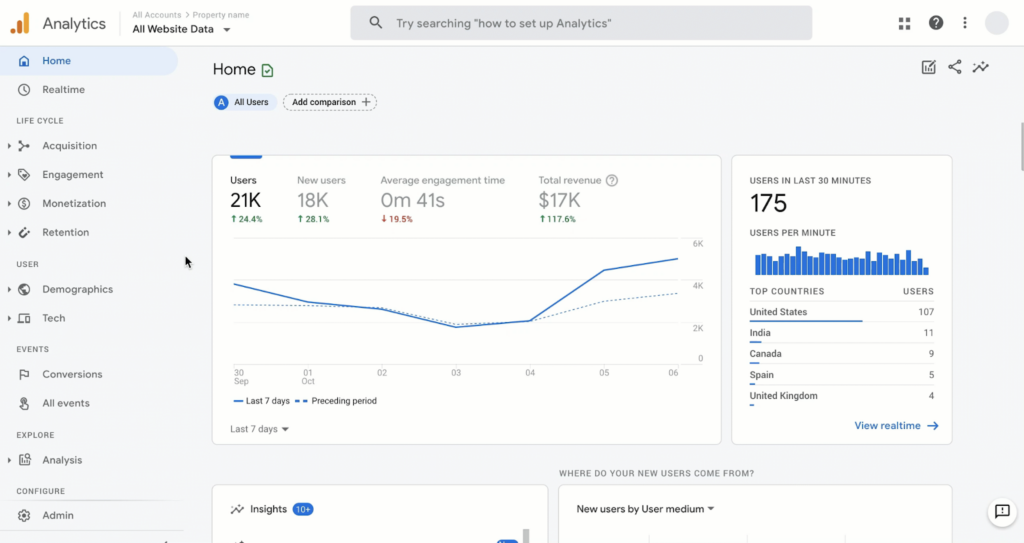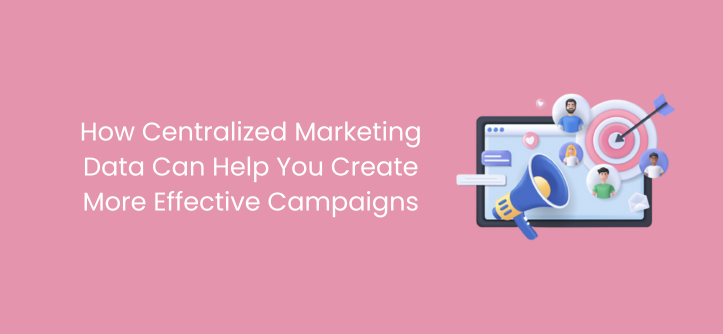Do you ever wonder whether you could be using your marketing data more effectively?
In today’s competitive business environment, data is everything. But how you store that data can have a disproportionate impact on how much you can usefully do with it. This article explores how to centralize your marketing data in such a way that your campaigns will enjoy a valuable boost.
But first, let’s look at the main reasons why you might consider rearranging data like this in the first place.
Benefits of Centralized Marketing Data
It’s not unusual to use data mart software to maintain a collection of marketing data for use by a single department. However, full centralization of your marketing data confers additional advantages you shouldn’t overlook.
Understand the Global Picture
For one thing, it becomes much easier to get a big-picture view of your operations. Which channels drive the most leads, and how do your customers interact with them? When you take a bird’s eye view of the data, you can begin to get a much fuller grasp of how well your campaign is working in specific areas.
This often has the happy result that different departments work better together. That’s because when everyone has direct access to the same information, it’s easier for them to understand each other’s priorities. For instance, if the marketing department wants to increase spending on a particularly successful channel, the finance team is much more likely to approve it if they can see the lead generation figures firsthand.
Proxy Servers
What is a proxy server? A proxy server acts as an intermediary between your device and the internet. It allows you to access web content indirectly by routing your internet requests through a different IP address. This provides several benefits, including enhanced security, privacy, and the ability to bypass geographical restrictions.
When it comes to centralized marketing data, a proxy server can be employed to gather information from different geographical locations. It allows businesses to access web content indirectly by routing their internet requests through different IP addresses associated with the proxy server. This enables marketers to gather data from multiple regions, helping them understand local preferences, trends, and customer behaviors.
Furthermore, using a proxy server can enhance the security and privacy of centralized marketing data.
Banish Data Silos
In fact, we can generalize this. Centralizing your marketing data removes the kinds of barriers to access that can cause problems. So it’s not just that you’re gaining positive interactions by improving access—you’re also removing negative ones.
Too often, decisions made by an individual department don’t take into account what’s going on elsewhere in the company. This can lead to issues further down the line if the needs of different teams come into conflict. When all your data is fully centralized, it removes the silo problem, and everyone makes strategic decisions based on a full dataset.

Control the Budget
When you’re using a large number of marketing channels in your campaign, it’s easy to lose track of how much is being spent where. This tends to happen when you’re juggling multiple ad platforms and switching between them.
If you have all your data in one place, you can tell at a glance how much of your budget is going to each channel. This makes it much less likely that you end up overspending on any particular one. And much more likely that you’ll make appropriate decisions about budget allocation.
Measure ROI more easily
A related financial benefit is that centralizing your marketing data makes it much easier to calculate the ROI of different channels. If you’re using CRM software tools, you’ll know how difficult it can be to translate that data into an ROI measurement precisely.
Part of the centralization process involves standardizing your data. Instead of looking at the ROI of each channel in isolation, this allows you to compare like-for-like and understand which channels are outperforming and which are laggards. This lets you adapt your campaign strategy in a focused way and reallocate budgets accordingly.
Improve Efficiency
Bringing it all together, it’s clear that centralizing your marketing data promotes increased efficiency. That’s because it helps all your teams collaborate effectively, all pulling in the same direction.
Because everyone has access to the same data, there’s no time lost asking for data and having to wait to receive it before moving on to the next part of the task. As a result, your business operations progress much quicker and more smoothly.

Image created by writer
How to Centralize Your Marketing Data
Hopefully, you’re persuaded that centralizing your marketing data is a good idea. But how do you actually achieve it in practice? Here’s a four-step plan to do just that.
Assess where you are
First, you need to carry out a full assessment of your existing position. You need to understand your current capabilities, including both the abilities and limitations of your tech infrastructure. The key point you need to establish is whether you can build upon your current software or if you’ll need to start from scratch.
Legacy code can pose difficulties here. If your tech stack is dependent on outdated code, it may not be possible to achieve data centralization just by adding to it. Implementing data centralization means integrating a variety of apps like marketing SEO tools, CRM, CMS, and business intelligence software. Trying to do this with persisting gaps between the different modules can result in security problems.
Create a Dedicated Space for Your Data
The next stage is to decide where and how you will store your data. This essentially comes down to a choice between using on-site servers or going for a cloud-based option. If you decide to go the on-site route, that means buying a lot of expensive hardware and having technical teams in place to maintain it.
So it’s understandable that these days, many businesses prefer to use a cloud-based data lake or warehouse for the purpose. It’s a much more flexible and scalable solution. Using a third-party platform has the added advantage that you’ll benefit from built-in security protocols.
Integrate your Data
Once your designated space is ready, you can begin the process of data integration and consolidation. In some ways, this is the trickiest part of the job. That’s because it involves transforming data into a unified format, which isn’t always easy. The right approach is to create specific data fields for particular metrics, which may be named differently across different channels.

Image sourced from Google
It’s crucial to get this right, as it will have a big impact on your analytics. When you normalize your data, it encourages precise reporting and analysis that can help you gain new insights into your marketing campaigns.
Share the Data
Finally, set up a dashboard where you can stream all the data you’ve collected for analytics purposes. This needs to be user-friendly and have an intuitive interface so that everyone can use it with no need for extensive training programs.
One excellent aspect of having centralized your data is that you’ll have a broader range of options for data visualization. This makes it much easier to identify themes and trends, which can help you refine and improve your campaign strategy.
Nailing your Marketing Campaigns with Data Centralization
So, in terms of campaign success, what practical results will you see when you centralize your marketing data? Let’s look at some of the biggest upsides of the process.
Generates actionable insights
First, being able to review the data this way leads to genuinely actionable insights that you can leverage to optimize your campaigns. By consolidating data from various marketing channels and touchpoints, you can conduct in-depth analysis to identify patterns, trends, and correlations.
This analysis can tell you a lot about consumer behavior, preferences, and engagement levels, which, in turn, helps you make data-driven decisions.
Creates testing opportunities
Centralized data provides a foundation for conducting A/B tests and experiments. By comparing different marketing strategies, messages, or creative elements, you can measure their impact on key metrics and identify the most effective approaches to optimize your campaigns. For example, you could test how your audience responds to consent based marketing over the more traditional permission marketing.

Image sourced from splitmetrics.com
Related to this, you can also implement effective attribution models to determine the impact of various marketing efforts on customer conversions. This helps you allocate marketing resources more efficiently by identifying which channels, campaigns, or tactics contribute the most to successful conversions.
Simplifies Customer Journey Mapping
Another great benefit of centralizing your data is that it makes it much easier to map out the customer journey across different stages, from initial awareness to conversion. By understanding the key touchpoints, interactions, and website engagement metrics, you can identify potential bottlenecks.
Smoothing these out will lead to a better customer experience. You’ll also be able to personalize marketing messages based on specific stages of the journey.
Improves your Segmentation and Targeting efforts
Analyzing data stored centrally makes it much more straightforward to segment your audience based on demographics, behaviour, interests, or other relevant criteria. This enables you to create highly targeted campaigns tailored to specific customer segments, including those influenced by word-of-mouth marketing, resulting in improved engagement and higher conversion rates.
By incorporating word-of-mouth marketing into your centralized data approach, you can unlock additional insights and opportunities to enhance the effectiveness of your marketing campaigns, such as utilizing the impact of brand advocates, and customer testimonials to enhance the effectiveness of your marketing campaigns.
Take your Marketing Campaigns to the Next Level
Your marketing data is a valuable commodity. It can tell you a lot if only you’ll let it. Pulling it together so that it’s all in one centralized data repository makes sense because only by doing that can you take full advantage.
The benefits to be gained are immense. Right away, your business will experience higher productivity and efficiency since your teams will be able to collaborate more effectively. But you’ll also find continuing upsides cascading down the line as you begin to build a more comprehensive understanding of how your campaign is working (or not) on a granular level.
In short, it’s time to get that marketing data working for you and delivering for your customers.
_____
Author’s Bio: Pohan Lin is the Senior Web Marketing and Localizations Manager at Databricks, a global Data and AI provider connecting the features of data warehouses and data lakes to create Databricks lakehouse architecture. With over 18 years of experience in web marketing, online SaaS business, and e-commerce growth. Pohan is passionate about innovation and is dedicated to communicating the significant impact data has in marketing. Pohan Lin also published articles for domains such as Landbot and PPC Hero.




